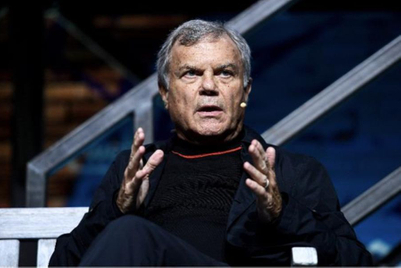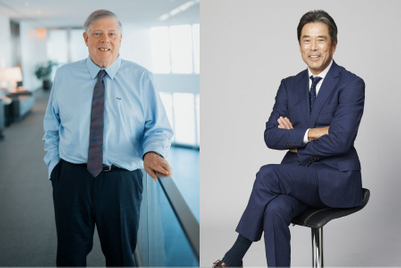.jpg&h=570&w=855&q=100&v=20250320&c=1)
Mark Penn, CEO of Stagwell, knows a thing or two about reshaping landscapes. For decades, he's operated from the war rooms of presidential campaigns to the boardrooms of global corporations.
The strategist who guided Bill Clinton through impeachment, advised on Hillary Clinton's Senate victory, and contributed to Tony Blair's third-term win has built a career on understanding how major structural changes affect the organisms around them. At Microsoft, as executive vice president and chief strategy officer, he helped steer the tech giant through a period of seismic industry shifts. As worldwide CEO of Burson-Marsteller, he gained firsthand experience managing the complexities of a global agency network.
Now, as advertising's latest power play unfolds with the impending $31 billion Omnicom-IPG merger, Stagwell (parent of agencies including 72andSunny, Assembly, Forsman & Bodenfors, and Harris Poll) chairman and CEO Penn's assessment draws on his blend of political instinct and corporate experience. His verdict? The industry is about to enter an extended period of transformation that could redefine its competitive dynamics.
"They're going to go through a year of regulatory review, then they'll probably go through a year of reorganisation," says Penn, who has engineered his own industry moves, including building Stagwell from zero to $2.5 billion in revenue over the past decade. Reflecting on industry consolidation, he adds, "I'm rather surprised by the entire notion of it, especially after the experience of WPP, which I think was simply that when you get too big, it's very hard for you to roll with the kind of transformation that occurs technologically in the industry."
Penn's insights extend beyond theoretical observations, drawing from his own experience exploring a defunct potential merger with Martin Sorrell's S4 Capital. "The issue was really that Martin Sorrell didn't want to entertain the proposition, and so we never progressed anywhere as a result," says Penn. Despite this, he acknowledges the strategic potential that the combination could have unlocked: "He was stronger in mass content, and I believed that individually he would not find a lasting marketplace, but as part of Stagwell, which really had the entire chain from Tier 1 creative to social to content, I think he would have benefited greatly through this combination." Ultimately, Penn shares, Stagwell pursued its growth independently, building its capabilities through other acquisitions.
Ironically, akin to Sorrell who spoke to Campaign last week, Penn predicts that up to 10,000 industry professionals could be affected by cost-cutting measures of the Omnicom-IPG merger to achieve promised synergies. "They've had to put out to Wall Street to justify the transaction of large-cost synergies because otherwise the investors would turn the other way," he explains. While such moves are standard in mergers of this size, much like Sorrell, Penn too emphasises the human cost, describing it as "devastating" for those directly impacted. He suggests the merger may also disrupt traditional pitch dynamics: "In pitches, they give out four to six slots. Are they going to give them two slots anymore? I don't think so." This potential shake-up, he believes, could create new opportunities for smaller, more agile agencies.
Creativity sparks the machine
Stagwell is developing what Penn calls 'The Machine'—an initiative focused on managing widespread libraries of content efficiently. “Today, virtually any company will have vast libraries of content that have to be managed, but that content still requires creative sparks,” he explains. The platform leverages AI to streamline content organisation and production, particularly for Tier 2 and Tier 3 creative work, without replacing the human ingenuity needed for top-tier ideas. Stagwell’s AI-powered tools, such as SmartAssets, optimise performance and facilitate instant adjustments, while platforms like PRophet predict media interest and generate content to enhance outreach.
This balance between technological efficiency and human creativity exemplifies Penn's broader view on AI's role in the industry. Far from seeing it as a threat, Penn remains confident in the industry's resilience and the enduring value of human creativity. "Creativity in many ways will become more important because it will become harder to differentiate," he explains. While AI can streamline Tier 2 or Tier 3 content creation, Penn insists that "those basic ideas on Tier 1 can still come from incredible creativity." The challenge, as he sees it, isn't about replacing creativity with technology, but rather leveraging both in complementary ways.
As for Stagwell, Penn sees a clear limit to growth. "We've come from zero to two-and-a-half billion in 10 years. And I'd like to see us get to double that size, but I don't think beyond double that size there'll be any advantage whatsoever," he says. Beyond that, complexity begins to outweigh the benefits.
This measured approach extends to the company's global expansion strategy, particularly in emerging markets. Rather than replicating the traditional network model of "a person in every single city”, Stagwell focuses on establishing strategic hubs, an approach that has been particularly evident in their Middle East expansion this year.
When the markets shift, strategies follow
The potential impact of geopolitical shifts, especially in Asia-Pacific, weighs heavily in Penn's strategic calculations, with the upcoming US election poised to reshape regional dynamics—in particular around incoming tarrifs. His recent polling of global CEOs reveals stark contrasts: “Global CEOs and the CEOs in the US thought that policy [changes] would be good for their business, and CEOs in China thought it would be bad for their business if Trump won,” he explains.
The implications for China could be particularly significant. “Those who have heavy manufacturing in China are going to go through a rocky time unless China is willing to open its economy more in exchange for lower tariffs,” Penn notes, pointing to the uncertainty that looms over the region. By contrast, India appears to be navigating a different path. “I think Modi may have a better relationship with Trump,” he observes, adding that India’s focus on modernising and developing its economy positions it as a rising force. “India is a democracy and I think is moving more towards [global] realignment, and I think Trump will be looking for evidence of that.”
For businesses, such geopolitical uncertainties often prompt hesitancy around investment, yet Penn challenges conventional wisdom. Dismissing industry narratives of shrinking budgets, he notes wryly, “Companies have said that they’re shrinking their budgets for 100 years.” Instead, he argues that performance marketing has strengthened the link between spending and results: “When you cut marketing, you cut your own revenue.”
The challenge of maintaining consistent marketing strategy extends beyond budget considerations to also encapsulate leadership transitions. Penn sees a generational shift occurring in the CMO role, one that could also fundamentally change not just spend, but client-agency dynamics. "We're going to have a new generation of CMOs that really are born digital, as opposed to the older CMOs that were really born TV," he observes. The current pattern of frequent CMO turnover has created significant challenges for agencies. "Some of the most frustrating stuff for us in agencies is that when the CMO changes everything that was good is bad and everything that was bad is good," he explains. This constant reversal of strategy, where new CMOs often dismiss their predecessors' initiatives while introducing their own, creates instability in agency relationships and disrupts long-term marketing effectiveness. Penn hopes the next generation of digitally native CMOs might break this pattern, bringing more stability to marketing strategies and agency partnerships.
Penn emphasises the need for collaboration in large organisations, an area where he believes traditional giants often fall short. Drawing from his experience with acquisitions at Stagwell, he highlights the delicate balance required: "You've got to create a team of leaders who care about the uniqueness of their brands, but also understand that only through working together can they fully satisfy the complex needs of large clients." This collaborative approach, he observes, has often been missing from larger network structures.
Onwards and upwards
Circling back to Omnicom-IPG, Penn remains unconvinced about the benefits of such consolidation. “I don’t think the industry needs another huge behemoth,” he says. While he acknowledges the eventual success of past deals—“a lot of people doubted the Publicis deal for a while... but they were successful”—he remains cautious about this latest move. Still, he concedes, “I don’t want to foreclose the possibility. They will be successful in ways that I haven’t predicted.”
Looking ahead, Penn sees opportunity amid upheaval. “During this period of regulatory review and cost-cutting, we’ll have great opportunities—in clients, talent, and drawing a clear contrast between our approach and theirs." The focus, he emphasises, is on thriving through transformation, balancing technological advancement with creative excellence, and building an industry fit for the future. With characteristic optimism, he leaves it at this: “Onwards and upwards.”


.jpg&h=334&w=500&q=100&v=20250320&c=1)


.png&h=334&w=500&q=100&v=20250320&c=1)

.jpg&h=334&w=500&q=100&v=20250320&c=1)
.png&h=334&w=500&q=100&v=20250320&c=1)
.png&h=334&w=500&q=100&v=20250320&c=1)

.png&h=334&w=500&q=100&v=20250320&c=1)


.jpg&h=268&w=401&q=100&v=20250320&c=1)

.png&h=268&w=401&q=100&v=20250320&c=1)
.jpg&h=268&w=401&q=100&v=20250320&c=1)

